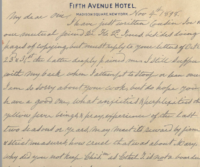Archival Journeys of the Letters

We have tried to trace something of the provenance of the letters, and in so doing, recognized remaining mysteries, both about JLN and the whole process of knowledge creation. There is mystery in the mere miracle of the survival of her letters, their presence today. For more on this see the section on the McConnell letters. We also recognized that the actual letters, according to New York custom among lawyers, would have been returned to those to whom JLN wrote. They then had ownership of the paper on which JLN wrote once, but not of her ideas. Likely many of these ideas, facts, and boring details would have then been destroyed. But the printed version made from them survived and became another archival transformation. The court case letters, or rather the copies of letters submitted as evidence, were preserved according to rules and practices of the NY courts. For a discussion of that recordkeeping, see here. The letter in the family papers, on the other hand, did not have to be preserved, except that McConnell and a few others, thought they should be. The archival memory, here as elsewhere, is potentially not achieved, is tenuous, because of so many other factors (including the complexity of the case, its privacy, and no one established path in which lawyers leave records to their firms, to libraries, to any place). The briefs, and within them Newcomb’s letters, become another extension of her thoughts into the world, steps now made much closer together since some are online, and thus, within yet another archival transformation.
We found, for example, that Ida Richardson was glad she had destroyed many of her letters from Newcomb. She said, in the court testemony, in essence one does this when one has too much. But maybe she also wanted them to stay private, wanted not the messiness of Newcomb’s hard years to emerge in the court record, at least not as coming from her, Newcomb’s longstanding friend.
We also found, in reading the court case letters particularly, that there is another direction one can go, in tracing ownership, ideas, and especially, intent and function in letters. Letters, especially those written to friends, are aspects of evolving selves, but ones ejected out. They tell the momentary, they tell what is changing all about oneself. Newcomb, so seemingly self-centered, nevertheless did not quit trying to leave that self, to write herself out of that preoccupation. That, besides the idea that letter writing was important to her, is our main conclusion: that she was blessed with a long life in which she used her words to evolve, to sort out the world around her. Maybe we want more from her, for example. want to have her mention what kind of mother she did have, what her mother died of, and when and how; to discuss the lives of slaves and newly freed peoples, the terror of Jim Crow life, and the harsher realities of labor conditions for millions; to get over the heartbreak for and with her sister, show pity for her and her children; or tell us more about how they judged her insane, incompetent. But the body of letters we have possess their own way, her own path, evolving and also private.
The court had more orthodox words, more suited for what they had to decide. The judge said she was “a woman of decision and independence.” Her estate’s lawyers acknowledged the personal importance of the letters she wrote that they had in hand, their “sacredly private character.” What more can be said? She comes across as someone at once threatened and empowered, not just by losses of her family, but by money itself, by possessing a strong will, a self-righteous attitude, and kindness. She also comes through as someone who passed through stages of grief to emerge ultimately generous. She did something any mother of a deceased child would do: she made that child’s memory live in a way that marked her time on earth and helped others to live.
There is a jagged history of the briefs associated with the case. We intend to investigate when they were bound and placed in libraries. Each state varied in practices, and each lawyer varied, as well, in whether to save the briefs, to have them bound. Attention to how legal evidence figures in the work of historians and biographers has been scant. Two not-so-recent comments on this lack of attention can be found in Seymour V. Connor, “Legal Materials as Sources of History,” American Archivist, vol. 23, 2 (1960): 157-165 and Allen Weinberg, “Court Records—Orphans Among Archives,” American Archivist, vol. 23, 2 (1960): 167-174.
